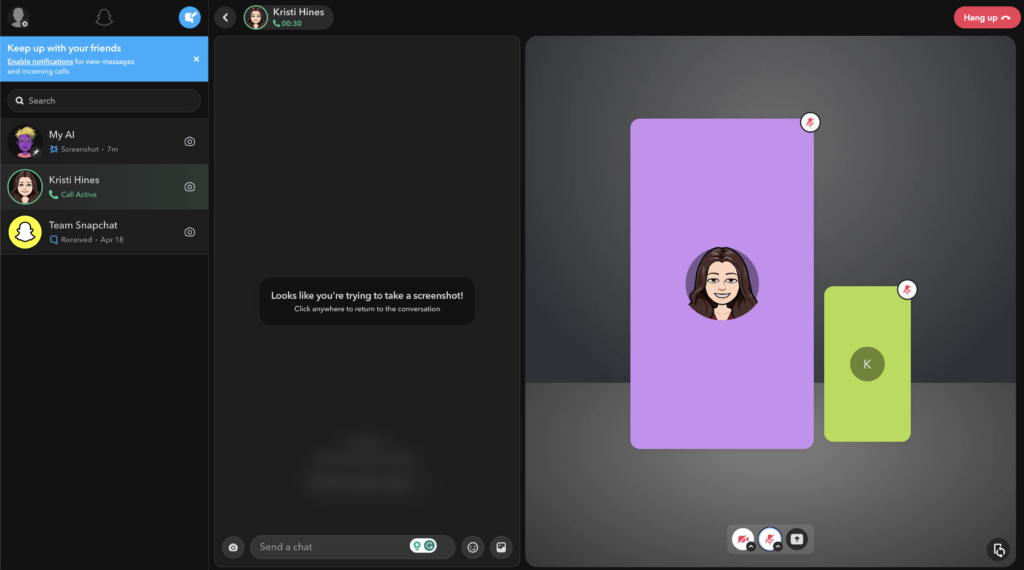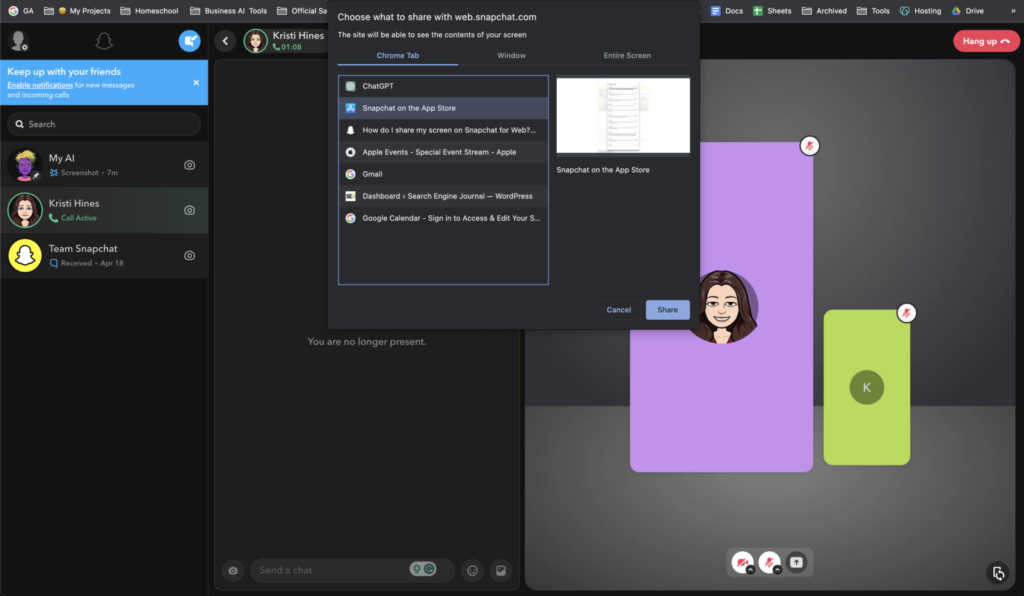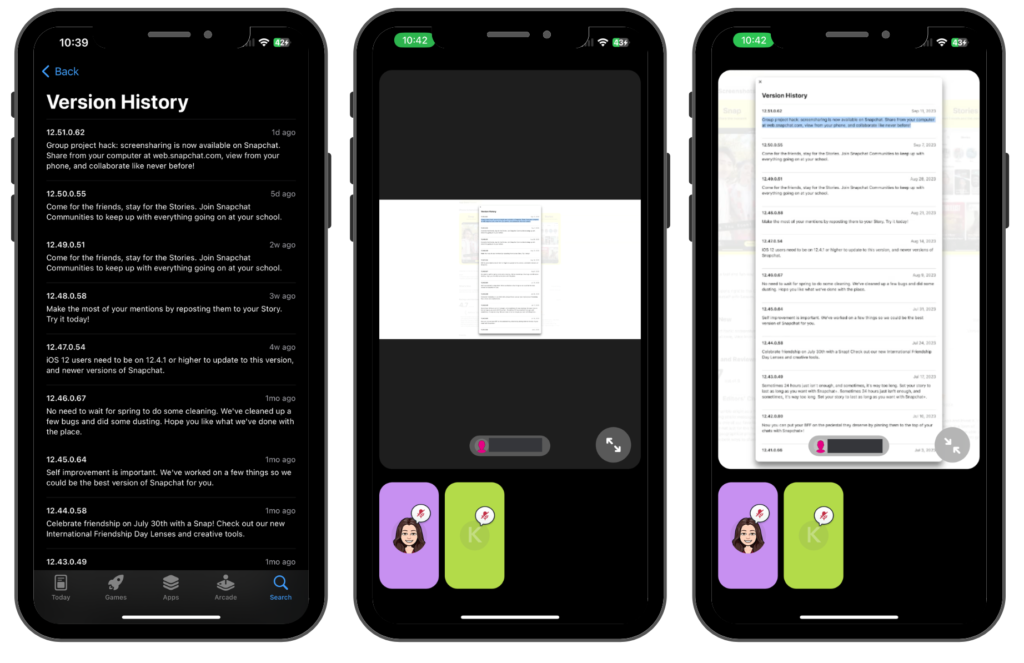Snapchat Introduces Screen Sharing Feature For its Web Users
With the inclusion of screen sharing, Snapchat, the multi-media messaging software has made a big advancement in its technological capabilities. The platform is historically only known for its messages that vanished. On the web version of its platform, the company has launched a new feature that enables users to screen share during calls. Snapchat had previously concentrated on image-based communication and brief video. It appears that the platform is attempting to expand its functionality with screen sharing, perhaps with an eye toward the industry that is now dominated by Zoom and Microsoft Teams.
Benefits of Screen Sharing on Snapchat
Convenient communication
The simplicity of screen sharing on Snapchat is one of its advantages. As they can see everything in real time, there is no need to provide screenshots or videos of what you want to communicate with someone. When demonstrating a new program or game or teaching a hard concept, this can be helpful. Utilizing this tool, nevertheless, requires caution since it raises potential privacy issues.
Sharing a screen facilitates more efficient conversation. It can be difficult to successfully communicate some concepts when all that can be done through texting is transmit text messages or, at most, photos. However, one may quickly convey an idea graphically or tell the other person how something works through screen sharing.
Problem-solving
Second, screen sharing facilitates learning and problem-solving. It’s especially helpful when attempting to solve computer-related issues, such as diagnosing software problems or instructing someone on how to properly utilize a specific program.
Collaboration
Last but not least, employing Snapchat’s screen-sharing feature encourages interaction among team members who are digitally working together across multiple locations at the same time, making life easier for everyone concerned.
In conclusion, Snapchat’s screen-sharing function offers a variety of advantages that enhance communication effectiveness and foster deeper interpersonal engagement.
Screen Sharing with Snapchat
Screen sharing has long been a standard feature of business-oriented digital communication tools. It is now also accessible for private use on social media sites like Snapchat.
How to share a Snapchat online screen
- Users must sign into their Snapchat account via the mobile app or the website at web.snapchat.com in order to enjoy the new screen-sharing feature.

Image credit- Search Engine Journal
- The next step is to start a call with a friend or a group after logging in.

Image credit- Search Engine Journal
- The share button is located at the bottom of the screen near the video and microphone controls. Users may share their screen by clicking it.

Image credit- Search Engine Journal
- Users can collaborate more fluidly online by sharing from their PCs and seeing from their phones.
Users can share their screen with other Snapchat users when using the iPhone app. However, users must be using the online interface.
The most recent changes for Snap users
The function may alter how common users collaborate online. Whether it be students working on group projects or families attending online activities. Businesses and marketers may also use Snapchat in novel ways to connect with target clients on the well-liked site. Overall, it’s evident that Snapchat always aspires to enhance its user experience through the introduction of creative updates designed to raise the caliber of our online discussions while integrating some entertaining components into it. This social media platform is one to keep an eye on because of its enhanced screen-sharing capabilities, which create limitless opportunities for interaction among friends across diverse geographic areas and give users access to a large variety of third-party programs via Mini-apps.
Read More: Lemon8, TikTok’s sister app struggles in the US, users cite inorganic feel and influencer bias
Author Profile

- Netra
- Netra is a Dual Masters graduate in International Business and Marketing. She is a content-writing enthusiast and a social media addict. In her downtime, you will find her headbanging to Pop songs from around the world. She is also a sports fanatic and especially loves F1, Volleyball, and Cricket. Her hobbies are baking and watching Anime.
Latest Posts
 MediaJuly 26, 2024Rediffusion Unveiles Konjo, a Specialist Agency for New Age Startups
MediaJuly 26, 2024Rediffusion Unveiles Konjo, a Specialist Agency for New Age Startups MediaJuly 26, 2024Farah Golant Joins Seedtag Board of Directors
MediaJuly 26, 2024Farah Golant Joins Seedtag Board of Directors MediaJuly 26, 2024PRCA MENA Announces Imad Lahad as Vice Chair of the Board
MediaJuly 26, 2024PRCA MENA Announces Imad Lahad as Vice Chair of the Board MarketingJuly 26, 2024Google Shelves its Plans to Remove Third-Party Cookies | Experts Speak
MarketingJuly 26, 2024Google Shelves its Plans to Remove Third-Party Cookies | Experts Speak










